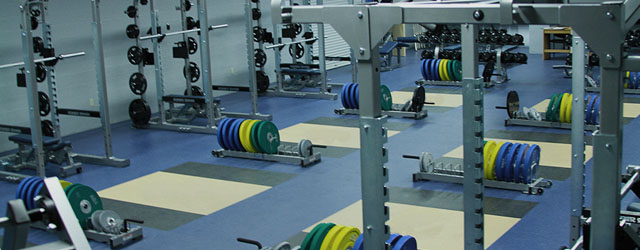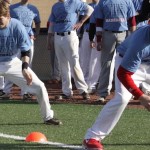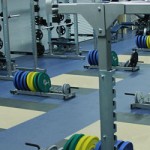
It’s the best time of year. Spring training is underway in Arizona and Florida, college baseball just opened its season, and high school ballplayers all over the nation are preparing to start their seasons in the next few weeks. Over the last few months, ballplayers at every level have been gradually building up their training intensity to prepare their bodies for the demands of a long season. But, with the first pitch of the new season comes a bad habit among many at the high school level. The season starts and training ceases. The biggest reason for neglecting the weight room: time. Apparently, there just isn’t enough of it during the season.
Find the Time
Listen, in-season training is important. If you expect to maintain your off-season gains, maximize your recovery, and reduce your risk of injury, you have to train during the season. Players at the Major League level play everyday and they still find time to mix in their strength training. For the high school ballplayer who plays 2-3 games per week, there should be no problem finding time for the weight room. Just 30 minutes once or twice a week can make a difference over the relatively short 20-25 game season.
Finding the right day will be important. Typically, there should be a day or two between games, so one of the best times to train is after a game. This will give you plenty of time to recover before the next game. For the same reason, another great time to train would be the day before an off day. For the more visual person, here are some examples of what a week might look like during the high school season and where you can fit in your training sessions. These assume you are training two days per week. Remember, these are just examples. Your needs and schedule may be different and you should adjust accordingly.
|
Sunday |
Monday |
Tuesday |
Wednesday |
Thursday |
Friday |
Saturday |
| Off | Practice |
Game Strength Training |
Practice |
Practice |
Game |
Strength Training |
|
Sunday |
Monday |
Tuesday |
Wednesday |
Thursday |
Friday |
Saturday |
| Off | Practice Strength Training | Practice | Game | Practice |
Game Strength Training |
Off |
| Sunday |
Monday |
Tuesday |
Wednesday |
Thursday |
Friday |
Saturday |
| Off |
Practice Strength Training |
Practice |
Practice |
Game |
Practice |
Game Strength Training |
Quality Training Sessions
So, how do you go about training in-season? Should you just continue what you were doing in the off-season? Absolutely not. Obviously, the demands of the season are tough. You need to be at your physical best to play in competition, and training at an off-season volume will only insure that you are sore and fatigued come time to take the field. Furthermore, you need to stay healthy. Missing games are never fun, and staying on the injured list is a guaranteed way to miss games. The intensity of your session should stay relatively high, but your volume should be significantly lower than your off-season training program.
- First and foremost, you need to be taking care of your shoulders. That throwing arm will not protect itself, so you need to make sure you are making every effort to not skip your tubing and other rotator cuff exercises. This is especially true of pitchers. Take care of your arm, and it will take care of you.
- Furthermore, not all exercises are created equal. You are already pressed for time, so you need to get the best bang for your buck on the movements you are performing during your training sessions. A solid clean variation, squat variation, or deadlift are all quality choices. Remember, high intensity, low volume. That means 1-2 sets for 6-8 reps for these bigger lifts.
- Don’t be afraid to hit the legs hard. With your upper body, you need to be a little more cautious. Anything that can compromise the integrity of the shoulder should be done in moderation or not at all. Opt for push-up variations over a heavy bench press or incline press. Rows and pull-ups are great for keeping that back strong.
- Foam rolling and mobility work will be key to your recovery, and can be done everyday if the need arises. Skipping this type of work is like skipping your workouts all together. Do it!
Sample In-Season Program
Now that you have an idea of what an in-season training program should consist of, let’s put it all together and give you an example of an in-season program for the high school ballplayer. The pre-hab, mobility, and foam rolling portions below can be done everyday.
Pre-hab
| Scapular Retraction | 2 x 15 |
| Tubing – Flexion | 2 x 15 |
| Tubing – Extension | 2 x 15 |
| Tubing – Internal Rotation | 2 x 15 |
| Tubing – External Rotation | 2 x 15 |
| Tubing – Internal Rotation at 90o | 2 x 15 |
| Tubing – External Rotation at 90o | 2 x 15 |
| Tubing – Band Pull External Rotation | 2 x 15 |
| Tubing – Band Pulls | 2 x 15 |
(For more information on tubing exercises and a shoulder program, check out ARMing for Success.)
Mobility
| 90/90 Stretch | 2 x 5 each side |
| Scapular Wall Slide | 2 x 10 |
| Reverse Lunge w/ Twist | 2 x 8 each side |
| Lateral Lunge | 2 x 8 each side |
| World’s Greatest Stretch | 2 x 8 each side |
Strength – Day 1
| DB Power Clean | 1 x 6 |
| Squat | 1 x 8 |
| TRX Push-up | 2 x 12 |
| Pull-up | 2 x 12 |
Strength – Day 2
| Deadlift | 1 x 6 |
| DB Bench Press | 1 x 8 |
| DB Lunge | 2 x 6 each side |
| TRX Row | 2 x 12 |
Foam Roller
| Glute Medius |
| IT Band |
| Quads |
| Adductors |
| Lats |
| Thoracic Spine |
Use Your Head
Remember, every player will be different. Pitchers may have more needs to consider than position players. Freshman and JV players may be able add a little more volume compared to varsity athletes. Your schedule may only allow for one day of strength training. Whatever it may be, just use your head. Your primary focus is to play. If fatigue and soreness creep up, then you may need to tone down the strength portion of your workouts and focus more on pre-hab, mobility, and foam rolling. Stay strong, stay healthy, leave it all out on the field.






6 responses to “In-Season Training for the High School Athlete”
[…] This post was mentioned on Twitter by Max Performance and Phil Tognetti, Phil Tognetti. Phil Tognetti said: New Post – In-Season Training for the High School Athlete | The Full Windup | http://wp.me/p17FO8-ac #baseball #strengthtraining #fitness […]
[…] here. The last thing we want is for you to be tired and sore for an upcoming game. Instead, your focus should be on staying strong and maximizing your recovery between practices and games. Keep the loads heavy, but decrease your volume by lowering the […]
[…] to high gear so you can start off the upcoming season with a bang. Once the season begins, your in-season training routine becomes mostly about maintaining strength and staying injury free. I touched on these […]
Hey Phil.
You asked what we would like for you to write about.
Well here goes.
I would like for you to write about a pitchers mechanics.
Tom House says that no matter what kind of a pitcher one is, {Fast ball}{Knuckle ball} {Side arm} etc that their mechanics are all the same.
Dr Andrews and his associates at their American Sports Medicine Institute in Bermingham Ala. have brought to the table that the pitchers body in motion from the first forward movement from the rubber on to it’s final non vertical, non upright finish position should operate within a series of sequenced chain reactive movements which should be executed at the proper time in their proper sequence.
There is never any detailed breakdown as to what these chain reactive movements consist of and what their proper sequence and timing are.
[…] that all your hard work is about to pay dividends. Don’t forget to continue to follow your in-season game plan to stay healthy throughout the year, and continue to execute, execute, […]
[…] to create a 12-week in-season baseball training program over at BreakingMuscle.com. I have touched on the subject of in-season training before, but the program that will be released on Breaking Muscle over the next 12 weeks is much more […]